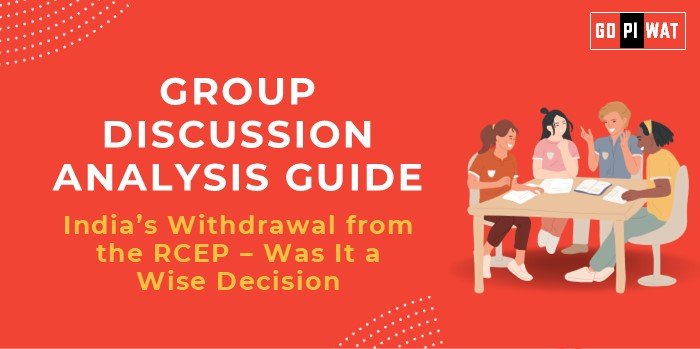🌍 Group Discussion (GD) Analysis Guide: India’s Withdrawal from the RCEP – Was It a Wise Decision?
🔍 Introduction to the Topic
- Opening Context: In November 2019, India chose to withdraw from the Regional Comprehensive Economic Partnership (RCEP), a significant trade agreement among 15 Asia-Pacific nations. This decision has sparked extensive debate regarding its implications for India’s economic and trade policies.
- Topic Background: The RCEP, initiated in 2012, aimed to establish the world’s largest free trade area, encompassing approximately 30% of global GDP and population. India’s withdrawal was influenced by concerns over potential adverse effects on its domestic industries, particularly agriculture and small-scale manufacturing, due to increased competition from member countries.
📊 Quick Facts and Key Statistics
- 🌏 RCEP’s Economic Scope: The 15 member countries account for about 30% of the world’s population (2.2 billion people) and 30% of global GDP ($29.7 trillion), making it the largest trade bloc in history.
- 📉 India’s Trade Deficit with RCEP Nations: In 2019, India’s trade deficit with RCEP countries was a significant factor in its decision to withdraw from the agreement.
- 🌐 Global Trade Dynamics: The RCEP agreement, which entered into force on January 1, 2022, saw trade between China and the 14 other RCEP member countries amount to 12.6 trillion yuan ($1.77 trillion) in 2023, an increase of 5.3% compared to the period before the agreement came into effect in 2021.
👥 Stakeholders and Their Roles
- 🏛️ Indian Government: Tasked with safeguarding national economic interests and ensuring sustainable growth.
- 🏭 Domestic Industries (Agriculture and Manufacturing): Concerned about potential competition from imports affecting local markets.
- 🤝 Trade Partners (RCEP Member Countries): Aimed to integrate India to enhance regional trade dynamics.
- 💹 Global Investors: Monitoring India’s trade policies to assess investment potential.
🏆 Achievements and Challenges
🌟 Achievements
- 🛡️ Protection of Domestic Industries: By not joining RCEP, India aimed to shield its agriculture and manufacturing sectors from potential adverse impacts due to increased competition.
- 🔓 Policy Autonomy: Maintained the ability to negotiate bilateral trade agreements tailored to national interests.
- 📈 Focus on Self-Reliance: Emphasized initiatives like ‘Atmanirbhar Bharat’ to boost domestic production and reduce dependency on imports.
⚠️ Challenges
- 🌐 Missed Trade Opportunities: Exclusion from a bloc representing a significant portion of global trade may limit market access.
- 📉 Strategic Isolation: Potential marginalization in regional trade discussions and economic collaborations.
- 💰 Competitive Disadvantage: Indian exporters might face higher tariffs compared to RCEP member countries, affecting competitiveness.
🌏 Global Comparisons
- 🇨🇳 China: Leveraged RCEP to strengthen its trade dominance in the Asia-Pacific region.
- 🇯🇵 Japan and South Korea: Advocated for India’s inclusion to balance regional economic dynamics.
📖 Case Studies
Atmanirbhar Bharat Initiative: Post-withdrawal, India launched the ‘Atmanirbhar Bharat’ campaign to promote self-reliance, focusing on boosting domestic manufacturing and reducing import dependence.
💬 Structured Arguments for Discussion
📈 Supporting Stance:
“India’s decision to withdraw from RCEP was prudent, prioritizing the protection of vulnerable domestic sectors from potential adverse impacts of free trade.”
⚠️ Opposing Stance:
“By not joining RCEP, India may have missed out on significant trade opportunities and regional economic integration benefits.”
⚖️ Balanced Perspective:
“While India’s withdrawal from RCEP protected certain domestic industries, it also necessitates strategic efforts to enhance global trade competitiveness through alternative means.”
🎯 Effective Discussion Approaches
- Statistical Impact: “RCEP encompasses 30% of global GDP and population; India’s absence raises questions about its trade strategy.”
- Policy Perspective: “India’s withdrawal from RCEP reflects a strategic choice to prioritize domestic economic stability over regional trade integration.”
📊 Strategic Analysis of Strengths and Weaknesses
- 📊 Robust Domestic Market: A large consumer base provides opportunities for internal economic growth.
- 🤝 Policy Flexibility: Ability to negotiate bilateral agreements tailored to specific national interests.
Weaknesses:
- ⚙️ Export Competitiveness: Challenges in matching the efficiency and cost-effectiveness of RCEP member countries.
- 📉 Trade Deficits: Persistent trade imbalances with several RCEP nations.
Opportunities:
- 🤝 Bilateral Agreements: Potential to forge strategic trade partnerships outside of RCEP.
- 🏭 Domestic Manufacturing: Initiatives like ‘Make in India’ can boost local production and employment.
Threats:
- 🌐 Regional Isolation: Risk of being sidelined in Asia-Pacific trade dynamics.
- ⚡ Increased Competition: RCEP members may gain competitive advantages in markets where India also seeks to export.
📖 Connecting with B-School Applications
- 🌟 Real-World Applications: Understanding India’s trade policy decisions is crucial for roles in international business, trade negotiations, and economic strategy.
- ❓ Sample Interview Questions:
- “How does India’s withdrawal from RCEP align with its broader economic policies?”
- “What alternative strategies should India pursue to enhance its global trade presence?”


